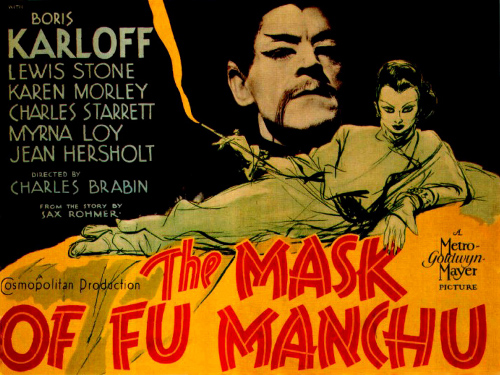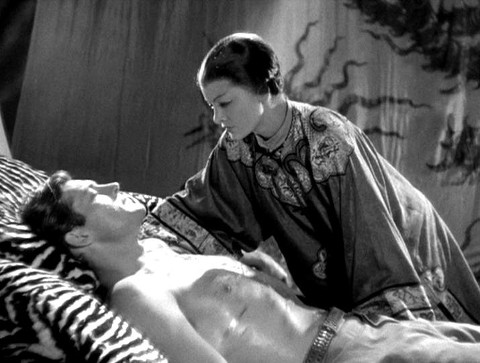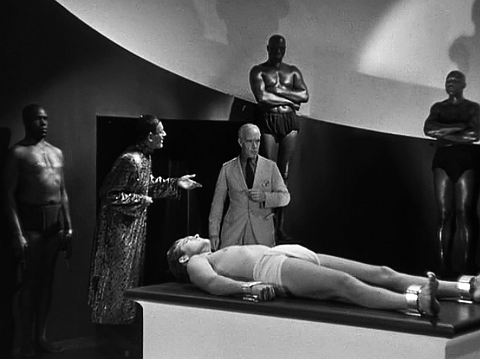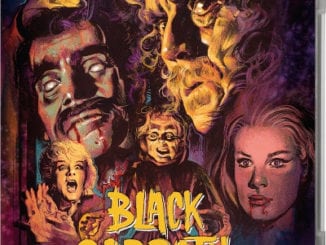The Mask of Fu Manchu (1932)
Directed by: Charles Brabin
Written by: Irene Kuhn
Starring: Boris Karloff, Charles Starrett, Karen Morley, Lewis Stone
USA
AVAILABLE ON REGION 1 DVD
RUNNING TIME: 68 mins
REVIEWED BY: Dr Lenera
In Mongolia, on the edge of the Gobi desert, lies the tomb of Genghis Khan, inside which are a mask and sword which, according to legend, will unable an Asian conqueror to rule the world. The evil Fu Manchu, domination of the planet being his objective, is looking for the tomb, assisted by his nymphomaniac daughter Fah Lo See. Against him is Sir Denis Nayland Smith of the British Secret Service, accompanied by Sheila Barton whose father has been kidnapped by the power-mad Asian super criminal so he can learn the location of the tomb….
The first half of the 1930’s really was a golden age of horror, a period of incredible creativity and artistry in the genre along with the fact that the Production Code didn’t get really strict until 1934, meaning that many of these films got away with things that others wouldn’t be able to for over 20 years. Universal led the charge with Dracula beginning a series that went on through the ’40s, but they didn’t have the field all to themselves. Some of the best and the most daring offerings like Dr Jekyll And Mr Hyde, The Island Of Lost Souls and Freaks came from other studios like Paramount and MGM. Being the recent owner for a paltry sum of a DVD set featuring six non-Universal pictures made by MGM and Warner Bros, I of course decided to review the films [as well as one a couple others which are related] in addition to watching them, most of which I hadn’t seen. The first of these is The Mask Of Fu Manchu, which some may not consider to be horror, though it was thought to be so at the time, tends to be lumped in with Boris Karloff’s many other horror films, and, seeing as Indicator are releasing the five ’60s/’70s films [review here] featuring Sax Rohmer’s oriental forerunner to so many screen bad guys after world domination, I thought I’d review it anyway. I remembered it as a reasonable pulpy adventure more interested in torture [in a way that’s surprising for the time] than action, and so blatantly racist that even I [regular readers will know my total and utter hatred for political correctness] felt uneasy. My viewing of the DVD evoked a similar reaction, though with my critical eye hopefully turned on there was a bit more to appreciate – and also a bit more to get annoyed with.
Charles Vidor started directing what would have been his first movie, but was fired after a few days of shooting for mysterious reasons and replaced by Charles Brabin – though he did marry Karen Morley who plays Shelia so it wasn’t all bad for him. Shooting began before a script had been completed, with Karloff being laughed at when he asked to read one. Changes kept being made, producer Hunt Stromberg wanting a giant robot to be it at one point, and Karloff was once given several new pages to learn in two hours. It took makeup artist Cecil Holland two and a half hours every morning to apply Karloff’s makeup. In filming the scene where Fu Manchu injects his mind control drug into someone’s neck, Karloff actually pushed the syringe into a baked potato which was lying on the table next to the other actor’s head, out of camera range. However, each time Karloff pressed the plunger down, the potato would explode until Karloff and Starrett couldn’t do the scene without laughing. Brabin finally gave up and dismissed the two for the day. Even more amusingly, in his scenes with Myrna Loy in which Charles Starrett was wearing only an abbreviated loincloth, retakes were frequently required because Starrett was showing too much – how should I put this? – “enthusiasm”. The film was a reasonable success but was criticised by the Chinese government, and the Chinese embassy in Washington launched a formal complaint against the film for its hostile depiction of the Chinese, while the film’s re-release in 1972 was met with protest from the Japanese American Citizens League, who stated that it, “was offensive and demeaning to Asian-Americans”. Due to such criticism, two minutes of footage was cut, though they were later restored and I believe the North American DVD, from which this review is taken, is the uncut version.
The premise is told to us in the very first scene, a conversation between Nayland [oddly pronounced as “Nigh-land” here] Smith and Lionel Barton; Fu Manchu is looking for Genghis Khan’s tomb and must be stopped. For those used to the later films with Christopher Lee as Fu, it’s odd having an elderly Smith, though his age doesn’t stop him from indulging in some derring-do at the end. Fu’s first appearance is a doozy, his face reflected in a large mirror looking even more distorted than he looks anyway due to Karloff’s makeup. Barton is captured in the British Museum by some of Fu’s minions disguises as mummies coming out of sarcophagi in a nice idea from which more could have been made out of, though it’s interesting that Karloff’s very next role was as – The Mummy. Fu tries bribing his captive by offering his own daughter Fah Lo See [who he later announces to others as being “ugly and insignificant” which I can’t work out is meant as a joke or not] so he’ll tell him where the tomb is, but that doesn’t work, so he then makes him undergo the Torture Of The Bell, where he’s placed underneath a huge, constantly ringing bell. Most films of the time, even those made before the Production Code became rigidly enforced in 1934, would have then cut to another scene and left the majority of the torture to our imagination, but this one cuts back to the plight of poor Barton not once but twice so we have to watch him dying from the pressure of the noise of the bell and lack of food and drink. Meanwhile Barton’s daughter Sheila is one of the leaders in the expedition to find the tomb, and find it they do, among talk of Tutankhuman’s curse and even writing on the tomb which curses those who open it. No living mummy materialises, but we do see a spider crawling out of the eye of Genghis’s skull in what must be one of the first uses of this device.
Despite the short running time, the pace doesn’t really speed up like you would expect it to as our English good guys find themselves in a place where Fu apparently has eyes everywhere and is after what they covet. But we do get a severed hand falling from a tree which you certainly wouldn’t have seen two years later. Sheila rather stupidly persuades her fiancee Terry Granville to take the relics to Fu without Smith’s knowledge, but Nayland has switched the sword, and being given a fake gets Fu to think of a particularly clever way to obtain what he wants; give Terry a serum which will make him obedient to Fu and hopefully fool the others. Fah also wants Terry to do her bidding, but in a rather different way. It’s hinted at quite strongly that he could be the latest of a series of sex slaves to Fah, even though Myrna Loy, probably tiring of playing vamps and Asians, holds back on the theatrics; well, except for when she shows considerable excitement at watching Terry being whipped. She disappears towards the end of the film, though some earlier versions of the script had her die helping the good guys. In any case, one wonders what the film’s two women see in Terry anyway considering American Charles Starret’s half-hearted tries at an English accent. Saying that though, Karloff makes no attempt to sound Chinese either. His relish at playing his first speaking role is palpable though; he’s clearly having loads of fun here. He also uses his natural lisp so it sounds very sinister.
This leads me to the very big elephant in the room. Now I find utterly baffling the fact that, these days, it’s basically not allowed for a white performer to play somebody of another ethnicity. Surely if somebody is suitable for the part, it shouldn’t really matter? However, I couldn’t help but come to the conclusion that the makeup Karloff wears here really is ugly and highly disrespectful to Asians, while his garb is a random collection of things from several Asian countries. His robe is a Chinese woman’s wedding dress! But then Fu was created as the ultimate personification of the ‘Yellow Peril’ [paranoia brought on by Asian immigration] several decades before by Sax Rohmer who featured the character in a series of novels and short stories. Pulp of this nature frequently assigned the roles of the victims of colonialism to its victims. “Will we ever understand these Eastern races? Will we ever learn anything?” is one of several instances of dialogue that wouldn’t make the grade today, though our plucky whites are shown as having no malice whatsoever while Fu rails against the west, ordering those gathering in his hall to, “kill the white man and take his women”. It was bits like this that make up the majority of the previously cut footage, though for me the most questionable scene is the final one, when Nayland asks a Chinese waiter, “you aren’t by any chance a doctor of philosophy, law, medicine” [three things which Fu was]? When the waiter says no, Nayland shakes his hand with the words, “I congratulate you”. The vile message is clear; oriental [or indeed on-white in general] folk are fine if they’re unintelligent, ignorant and subservient. Yet, despite my saying all this which may surprise some readers used to my anti-PC comments in reviews, in no way do I think that this film should be suppressed, even though I’m sure that if Disney had made it they’d pretend it didn’t exist, and the day may come when this film is in trouble. Cancel culture is one of the blights of our age.
Ignoring all this stuff, it’s still certainly possible to enjoy The Mask Of Fu Manchu, as entirely studio bound as it is and lacking a musical score as with most sound movies of the period. Things do eventually get going with lots of fun serial-type stuff; secret entrances, snakes, crocodiles, escapes from seemingly inescapable circumstances, last minute rescues, a death ray etc, even if the way the day is saved is awfully convenient and the scene seems to end before it’s properly finished. Fu’s underground lair seems to be where art deco, oriental cliches and German expressionism meet, while Brabin, though not really giving the material the verve it needs, does stage the occasional good tableaux; the most notable one is when Fu’s injecting Terry with the serum in a white room with nothing else in it except for five precisely placed black [not sure why they would be there, but never mind] guards standing on pedestals. A scene in an opium den and the air of sadism are reminders of how so less restrained pre-Code features were allowed to be – and I love the variation on the iron maiden which looks like a huge garlic press. I think it’s possible to find a film like The Mask Of Fu Manchu entertaining while still being aware of the ugliness existing at its core.
Rating: 

















Be the first to comment